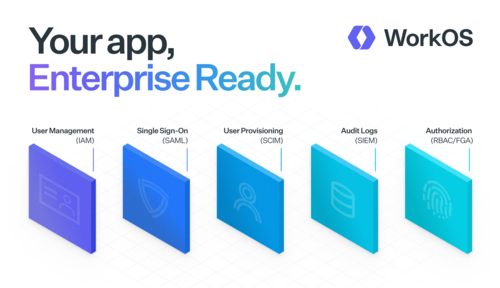🔗 View in your browser. | ✍️ Publish on FAUN | 🦄 Become a sponsor
DevOpsLinks
⭐ Patrons
WorkOS is a modern identity platform for B2B SaaS apps.
→ A complete user management solution along with SSO, Directory Sync (SCIM), and Fine-Grained Authorization (FGA).
→ Modular and easy-to-use APIs allow integrations to be completed in minutes instead of months.
→ High-quality documentation and seamless onboarding for your users eliminate unnecessary complexity for your engineers.
→ Free user management up to 1 million MAUs.
WorkOS powers some of the fastest growing companies like Perplexity, Vercel, Webflow, and more.
Start integrating today.
ℹ️ News, Updates & Announcements
In a monumental escalation of attack magnitude, Cloudflare autonomously mitigated a record-smashing 3.8 terabits per second hyper-volumetric DDoS attack lasting 65 seconds, surpassing Microsoft's previous record, with threat actors exploiting global infected devices, particularly Asus routers and Mikrotik systems, and leveraging CUPS vulnerabilities in Linux for potential amplification of such attacks.
Perfctl malware exploits over 20,000 Linux misconfigurations and patches CVE-2023-33246 with rootkits, camouflaging via deceptive process names and TOR, while secretly mining cryptocurrency—a stealthy threat to millions online.
Microsoft unveils Azure ND H200 v5 VMs with a 76% surge in High Bandwidth Memory and eight Nvidia H200 GPUs for AI supercomputing flexibility, alongside the FXv2-series VMs in public preview, boasting doubled vCPUs and enhanced IOPS for complex simulations and SQL workloads.
🐾 From FAUNers
A fintech startup faced unsustainable billing spikes with New Relic as they expanded its use across systems, discovering that critical cost-saving measures included segmenting log data, moving business logs to Grafana + Loki, storing past logs in AWS S3, and maintaining real-time observability for system health, illustrating the importance of an adaptive logging strategy as usage scales.
Clean code transforms development by emphasizing descriptive naming, adherence to style guidelines like PEP 8 for Python and static typing in TypeScript, breaking functions into manageable pieces, eliminating "magic numbers" with meaningful constants, and leveraging DRY (Don’t Repeat Yourself) principles to ensure maintainability and readability — all contributing to a more efficient, error-resistant, and collaborative coding environment that anticipates future needs.
🔗 Stories, Tutorials & Articles
Azure Bicep deployment with Azure DevOps streamlines Infrastructure as Code by leveraging YAML-based pipelines, workload identity federation for secure deployments, and subscription-level scoping to simplify resource management across Azure environments, allowing for individual deployment control and historical auditing, while encouraging best practices like feature branching and automated CI/CD validations that catch issues early in the development lifecycle.
Switching from Kubernetes to Nomad streamlined deployments but required efficient service discovery to ensure smooth routing; by leveraging Consul and an open-source NGINX module, the infrastructure achieved robust and scalable routing without the complexity and cost of NGINX Plus, offering a powerful, flexible solution ideal for teams looking to move beyond PM2 or seeking alternatives to Kubernetes with the HashiStack approach.
DevOps culture accelerates production but burdens developers and central teams with managing diverse cloud services, pushing companies toward solutions like Terraform modules to mitigate complexity, yet Netflix's innovations like ConsoleME, Repokid, Spinnaker, and an S3 Slackbot demonstrate how automating infrastructure tasks and creating sensible defaults can effectively alleviate developer overload and technical debt, ensuring cloud stability without stifling central teams.
In crafting efficient Docker images, prioritize minimizing layers by combining commands in RUN statements for smaller images, use CMD for default runtime behavior that’s easily overridden, leverage ENTRYPOINT for fixed commands, and always prefer exec form for robust signal handling, ensuring your container maintains predictable and flexible operations.
The author discovered that Go 1.22 improves routing directly in the standard library, avoiding manual setup, and showcased how sqlc simplifies SQL integration without learning an ORM; highlights include solutions for SQLite optimizations, addressing GC limits in Go 1.19 to prevent OOM, and Go's simplicity in deploying static binaries, though they're cautious about implementing security features without a framework.
HTTP servers, such as Go's, handle Content-Length via chunked transfer encoding when responses exceed buffer size, using hexadecimal to indicate chunks, enabling efficient data transfer without storing entire responses in memory—a clever mechanism prevalent since HTTP 1.1 and replaced by streaming in HTTP/2 and HTTP/3, though trailers allow post-body headers like digital signatures.
Github Actions offer Composite Actions for publishing and external use and Reusable Workflows for internal flexibility, both aiming to enforce the DRY principle by minimizing duplicated CI/CD script configuration in software delivery.
💬 Discussions, Q&A & Forums
⚙️ Tools, Apps & Software
A tool for Python developers to easily debug the HTTP(S) client requests in a Python program.
Ansible playbook for a kubeadm-based Kubernetes cluster installation on Linux (Red Hat, Debian, and SUSE-based distributions) with a single control plane node and multiple worker nodes for development and testing purposes.
Public Repository of Open Source Tools for Cyber Threat Intelligence Analysts and Researchers
🤔 Did you know?
Did you know that Facebook’s backend infrastructure is powered by a unique programming language called Hack? In 2014, Facebook introduced Hack, which is based on PHP but with added static typing, enabling developers to catch errors earlier while maintaining PHP’s dynamic nature. Hack was designed to improve performance and scalability for Facebook’s massive user base, handling billions of requests every day. It runs on Facebook's custom-built HipHop Virtual Machine (HHVM), which significantly optimizes code execution, ensuring fast page loads and real-time interactions for users across the globe.
😂 Meme of the week

🗣️ Quote of the week
“The major problems of our work are not so much technological as sociological in nature.” ― Tom DeMarco, Peopleware: Productive Projects and Teams

